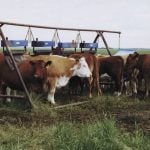Prepare for more dry times, grab hold of federal climate cash and keep watch for meaningful government action on the processing side.
Those are three key recommendations from a prominent educator, a producer and a farm leader on positioning the ranch for 2023.
Rainfall patterns have been different in the last three to five years and producers should prepare for a possible repeat next year, said cow-calf and forage systems expert Bart Lardner, a University of Saskatchewan professor.
Read Also

Lakeland College studying livestock wellness through cannulated heifers
Lakeland College’s Applied Research Team is working with six cannulated heifers on a handful of research projects.
“The Prairies are not receiving their normal levels of annual precipitation in the timely months of May and June,” he said, adding that many areas of Alberta and Saskatchewan have now been under drought watch for three years.
“Any event that we do see tends to be more severe thunderstorms with several inches of rain in the space of a few hours, which is not what we want.”
Part of Lardner’s advice is to partner with others if dry times strike again.
“Work with your neighbours,” he said. “Maybe you have one that is a grain producer or a crop producer. Can you partner with them and come in with your animals and clean up the crop residue? Maybe there’s a crop the neighbour grew that won’t make cash crop.”
He also recommends cutting back heifer replacements this year to something less than the typical 20 per cent.
“Maybe don’t go with your yearling grazing program in 2023,” he said. “Maybe stick to your breeding females. Realize, too, the herd has taken decades to build up, so producers really want to maintain numbers because that’s the number of cattle that are working for that operation to service debt and pay bills.”
Get creative when it comes to finding alternative fibre and hay sources such as ditch or slough hay or using straw or pelleted screenings, he advised, and take a close look at the feeding program.
“What I always say is cattle get used to the management system they’re under,” said Lardner. “Sometimes we can oversupply nutrients to the animals and we don’t realize we’re doing it. I think that in 2021 and 2022, a lot of folks realized they can balance diets on a different ration than what they’ve been providing.”
Farmers with multiple revenue streams should consider focusing their time and resources on the stream that’s making the most money, said Lardner.
“The bottom line is — this is the hard decision — they might have to disperse some of their animals for cash flow,” he said. “It may have taken them a long time to get where they are, and now they have to go backwards.”
The prospect of drought is one reason Ben Campbell recommends applying for grants from the $200 million On-Farm Climate Action Fund, which opened applications in August.
“It pays huge, 85 per cent of the cost for things like water systems, fencing and creek protection and all this stuff,” said Campbell, who ranches in the Black Diamond area.
“You’re going to say, what are we preparing against? Well, we’re preparing against drought. Those things allow you to increase your productivity by increasing your grazing management.”
Cattle farmers should also consider locking in an Agriculture Financial Services Corporation revolving loan with a three-year interest rate, he added.
“I have. Revolving loans — like if you don’t need it, you just don’t take any money out,” said Campbell. “You’ve got a guaranteed good interest rate. For example, I’ve got a rate locked in at under three per cent.”
Drought is also top of mind for Alberta Beef Producers chair Melanie Wowk as she looks ahead to 2023.
“We are running out of water,” said Wowk, who ranches near Beauvallon, about 160 kilometres east of Edmonton. “Even though we had some good moisture up here, our dugouts are pretty dry. Some ranchers should consider drilling additional wells on their property, but contractors and well casing are difficult to find.”
Beef prices are up from last year, but recently “took a tumble,” said Wowk, adding she fears more farmers will soon exit the business.
“If people don’t get the money they need to make some of their payments and dig their way out of last year, I think we are going to lose more people,” she said. “You look at the (average) age of our producers, which is over 60. If they’re not passing it on to the next generation, if cow prices recover and are relatively strong this year, I think that there will be more people selling.”
Wowk said producers should also watch for news on the political front.
In July of last year, the province said it was undertaking “a competitiveness study” with Alberta Beef Producers, Alberta Cattle Feeders Association and the Canadian Cattle Association. One of its key goals was to analyze the potential for “expanding harvest capacity for small to medium-sized processors and identifying the supports required for this growth.”
The results of that study will be available later this year and Wowk said she hopes it will be accompanied by an action plan.
“Hopefully there will be some guidance there to help improve the flow of money (and) maybe that’s going to be building some plants here in Alberta,” she said. “I hope to God that gives us some answers because boy oh boy, at the end of the day we need the next generation to start making some money.”















